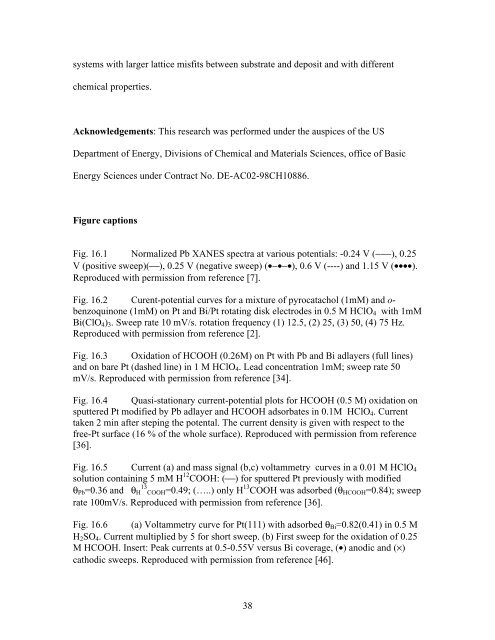electrocatalysis on surfaces modified... - Brookhaven National ...
electrocatalysis on surfaces modified... - Brookhaven National ...
electrocatalysis on surfaces modified... - Brookhaven National ...
Create successful ePaper yourself
Turn your PDF publications into a flip-book with our unique Google optimized e-Paper software.
systems with larger lattice misfits between substrate and deposit and with different<br />
chemical properties.<br />
Acknowledgements: This research was performed under the auspices of the US<br />
Department of Energy, Divisi<strong>on</strong>s of Chemical and Materials Sciences, office of Basic<br />
Energy Sciences under C<strong>on</strong>tract No. DE-AC02-98CH10886.<br />
Figure capti<strong>on</strong>s<br />
Fig. 16.1 Normalized Pb XANES spectra at various potentials: -0.24 V (−−−), 0.25<br />
V (positive sweep)(⎯), 0.25 V (negative sweep) (•−•−•), 0.6 V (----) and 1.15 V (••••).<br />
Reproduced with permissi<strong>on</strong> from reference [7].<br />
Fig. 16.2 Curent-potential curves for a mixture of pyrocatachol (1mM) and o-<br />
benzoquin<strong>on</strong>e (1mM) <strong>on</strong> Pt and Bi/Pt rotating disk electrodes in 0.5 M HClO 4 with 1mM<br />
Bi(ClO 4 ) 3 . Sweep rate 10 mV/s. rotati<strong>on</strong> frequency (1) 12.5, (2) 25, (3) 50, (4) 75 Hz.<br />
Reproduced with permissi<strong>on</strong> from reference [2].<br />
Fig. 16.3 Oxidati<strong>on</strong> of HCOOH (0.26M) <strong>on</strong> Pt with Pb and Bi adlayers (full lines)<br />
and <strong>on</strong> bare Pt (dashed line) in 1 M HClO 4 . Lead c<strong>on</strong>centrati<strong>on</strong> 1mM; sweep rate 50<br />
mV/s. Reproduced with permissi<strong>on</strong> from reference [34].<br />
Fig. 16.4 Quasi-stati<strong>on</strong>ary current-potential plots for HCOOH (0.5 M) oxidati<strong>on</strong> <strong>on</strong><br />
sputtered Pt <strong>modified</strong> by Pb adlayer and HCOOH adsorbates in 0.1M HClO 4 . Current<br />
taken 2 min after steping the potental. The current density is given with respect to the<br />
free-Pt surface (16 % of the whole surface). Reproduced with permissi<strong>on</strong> from reference<br />
[36].<br />
Fig. 16.5 Current (a) and mass signal (b,c) voltammetry curves in a 0.01 M HClO 4<br />
soluti<strong>on</strong> c<strong>on</strong>taining 5 mM H 12 COOH: (⎯) for sputtered Pt previously with <strong>modified</strong><br />
θ Pb =0.36 and θ H<br />
13<br />
COOH =0.49; (…..) <strong>on</strong>ly H 13 COOH was adsorbed (θ HCOOH =0.84); sweep<br />
rate 100mV/s. Reproduced with permissi<strong>on</strong> from reference [36].<br />
Fig. 16.6 (a) Voltammetry curve for Pt(111) with adsorbed θ Bi =0.82(0.41) in 0.5 M<br />
H 2 SO 4 . Current multiplied by 5 for short sweep. (b) First sweep for the oxidati<strong>on</strong> of 0.25<br />
M HCOOH. Insert: Peak currents at 0.5-0.55V versus Bi coverage, (•) anodic and (×)<br />
cathodic sweeps. Reproduced with permissi<strong>on</strong> from reference [46].<br />
38
















